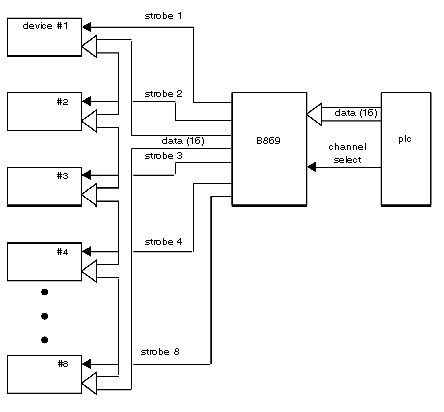The B869–002 register input module provides a 5 V TTL or CMOS-compatible interface between peripheral field devices and a PLC. The B869-002 is capable of inputting numeric 4-digit BCD data, or 16-bit binary data from field devices to the controller.
The module can operate in either BCD or binary mode. The desired mode is user-selectable, with the parallel 16-bit input having BCD values in the range 0000 to 9999 and the binary input in the range 0000 (HEX) to FFFF (HEX).
The B869-002 is an 8 channel device that operates in a channel select mode. In the channel select mode, only one channel (16-bit register width) is transferred during each cycle. This is accomplished by employing a simple form of handshaking with the PC. A channel select word is sent by the PC to the module, requesting data from a specific channel. The module then responds by sending the requested data, together with a channel select echo. Channel select mode requires 1 output and 2 consecutive input registers. The output register (Channel Select Reg) contains the address of the selected channel, while the 2 input registers contain the channel number echo and the data, respectively.
The following figure shows the schematic diagram for the B869–002 register input module.
The B869–002 operates with a 16-bit data path. Data is routed in from a device by means of a strobe line associated with each device. The data lines are common to all devices while the strobe performs the addressing function. The channel select function permits the PC to transfer a single channel of 16 bits from a selected field device to the PC during one OURBUS cycle.
The DC (data changing) signal from the field device is used for slowly changing data such as thumb wheel switches and prevents erroneous information from being transferred to the PLC.
To avoid loading the bus when a device is not being addressed, any active device interfaced to the input module must have latched, tri-state, or open collector outputs.
